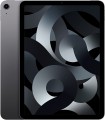Screen to body ratio
This parameter shows how much of the tablet's front panel area is on the display. The higher the display/body ratio, the thinner the frames and the more compact the tablet (with the same diagonal), the more elegant and aesthetically pleasing it looks. This indicator is also important when holding the tablet with both hands at once (for example, in games):
thin frames or even
frameless models allow you to reach further with your fingers without removing your hands from the device.
CPU
The model name of the processor installed in the tablet.
The processor is the “heart” of the device. It is he who is responsible for performing all the computing operations necessary for the normal operation of the tablet, and largely determines the overall performance. Knowing the name of a specific processor model, you can easily find detailed information on it, incl. and comparison with other models.
The most popular chips these days are from
Qualcomm(in particular, the top solutions
Snapdragon 800 series and
Snapdragon 8 series),
MediaTek(budget and “mid-range”
MediaTek Helio processors and the line of advanced
MediaTek Dimensity chipsets with 5G support), and among Windows tablets
Intel processors (mainly the
Intel Core family) are often found. Quite a rarity are branded
Kirin processors from Huawei and Honor.
CPU speed
The clock speed of the processor installed in the tablet is actually the maximum number of operations performed by one processor core per second. This indicator is important for the speed of the system, but a high clock frequency in itself does not guarantee speed. The actual speed of the processor also depends on its architecture, the number of cores and many other features, and the overall speed of the device also depends on the amount of “RAM”, the installed OS, etc. Therefore, situations are not uncommon when
powerful advanced tablets have a lower CPU frequency than more modest models.
CPU cores
The number of individual cores provided by the tablet processor.
The core is the part of the processor that executes a single instruction stream. Accordingly, the more cores, the more threads the processor can simultaneously process and the higher its performance (ceteris paribus). On the other hand, numerous cores is not always an indicator of a high class processor and tablet as a whole. First, the actual performance of the chip depends on many other factors, and advanced dual-core processors often outperform inexpensive quad-core processors. Secondly, the development and cheapening of technologies has led to the fact that simple
quad-core CPUs have become quite affordable even for low-cost devices. And even
eight-core processors, which at one time were an unequivocal sign of advanced models, are increasingly found in relatively inexpensive tablets; the same can be said about relatively recent
processors with 10 cores. However it is worth noting that in such chips, the cores can be divided into main (with high performance) and additional (used in tasks that do not require power). For example, 8 cores can be divided into 4 main and 4 additional cores. However, such a division is often not a disadvantage, but an advantage: numerous full-fledged cores is rarely required in fact, and reduced power saves energy and improves battery life.
Graphics card
Model of the graphics card installed in the tablet. The graphics card in such devices is not a separate device, but part of the processor; however, she still has a clear specialization and is responsible for graphics.
Accordingly, the graphics capabilities of the tablet directly depend on the characteristics of the video accelerator. Theoretically, knowing the name, you can find detailed specifications of a graphics card, reviews, test results and other information and evaluate how it suits you. At the same time, in most cases there is no need to delve into such details — all system components, including the graphics card, are usually selected in such a way as to correspond to the general class of the tablet and the capabilities necessary for this class.
RAM
The amount of random access memory (RAM) installed in the tablet. This memory is used for direct data processing, and therefore its volume is one of the main indicators of system speed and power. However note that the optimal amount of RAM strongly depends on the OS used — different systems and even different versions of the same "OS" can vary greatly in terms of consumed resources. But models on the same OS can be compared with each other in terms of the amount of RAM.
As for specific values, indicators in
1 GB or less in our time are definitely a sign of a weak tablet.
2 GB and
3 GB can be called the entry level,
4 GB and
6 GB are middle class, and in the most advanced models,
8 GB, or even
16 GB can be installed (or even more) RAM.
AnTuTu Benchmark
The result shown by a device when undergoing a performance test (benchmark) in the AnTuTu Benchmark.
AnTuTu Benchmark is a comprehensive test designed specifically for mobile devices, primarily smartphones and tablets. It evaluates the performance of the processor, memory, graphics, and input/output systems, providing a clear impression of the system's capabilities. The better the performance, the higher the score. According to AnTuTu, top models are those that score more than 500,000 points.
As with any benchmark, this test does not provide absolute precision; for more details on measurement inaccuracies, see the "3DMark Gamer's Benchmark" section.
Geekbench
The result shown by the device when passing the performance test (benchmark) Geekbench.
Geekbench is a specialized benchmark designed for CPUs. Since version 4.0, the test has also been applied to graphics accelerators; towards the end of 2019, the benchmark was released under the number "5". The characteristics of portable gadgets usually provide data specifically for the CPU. During testing, Geekbench simulates the workloads that occur when performing real-world tasks, and takes into account both the capabilities of a single core and the efficiency of multiple cores running simultaneously. Thanks to this, the final results characterize well the capabilities of the processor in everyday use. In addition, the test is cross-platform and allows you to compare the CPUs of different devices (smartphones, tablets, laptops, PCs). The help information only lists the multi-core test values for CPU.
Bluetooth
Bluetooth version supported by the tablet.
Bluetooth itself is a technology for direct wireless communication between various electronic devices. It can be used for various purposes, in particular, exchanging files with another Bluetooth device (laptop, mobile phone), connecting wireless headphones and headsets, peripheral devices (keyboards, mice), etc. The Bluetooth connection does not require both devices to be in line of sight and is stable as they move within range. The range and additional features depend on the connection version:
- 2.0. The earliest of the Bluetooth variations used in today's tablets. Provides a data transfer rate of about 2.1 Mbps.
- 2.1. This version differs from 2.0 in a number of improvements: enhanced security, reduced power consumption and compatibility with NFC technology.
- 3.0. This version is a combination of a Bluetooth 2.1 module and a high-speed add-on that allows you to transfer data at speeds up to 24 Mbps. Thanks to this, the connection is able to automatically adapt to the situation: for small amounts of data, a slow channel is used that does not consume much energy, and for large volumes, the high-speed part is used.
- 4.0. June 2010 version. It is notable for the fact that it combines three protocols: classic, high-speed and BLE (low power consumption). The latter is the most economical at the time of release - the power consumption is so low that the CR2032 "tablet" batteries la...st for several years of operation. The data transfer rate via the BLE protocol is up to 1 Mbps. According to the classical and high-speed protocol, Bluetooth 4.0 is almost the same as version 3.0 (see above).
- 4.1. Development of the version 4.0 described above. One of the key improvements was the optimization of collaboration with LTE cellular modules in order to avoid mutual interference. In addition, it became possible to operate Bluetooth devices simultaneously in several roles (for example, to broadcast audio to a headset and remotely control another device).
- 4.2. The next, after 4.1, is a key update to the Bluetooth standard. Introduced a number of key innovations for working in the "Internet of Things" (Internet of Things), as well as general improvements in speed and noise immunity.
- 5.0. Bluetooth version 5.0, introduced in 2016. In general, it continued the trend set by the 4.2 standard, has even more extensive opportunities for working with the Internet of Things. In particular, in the Bluetooth Low Energy protocol (see "4.0" above), it became possible to double the data transfer rate (up to 2 Mbps) at the cost of reducing the range, as well as quadruple the range at the cost of reducing the speed; in addition, a number of improvements have been introduced regarding simultaneous operation with a large number of connected devices.
- Bluetooth v 5.1. Update of the version described above v 5.0. In addition to general improvements in the quality and reliability of communication, this update has implemented such an interesting feature as determining the direction from which the Bluetooth signal is coming. Thanks to this, it becomes possible to determine the location of connected devices with an accuracy of a centimeter, which can be useful when searching for various accessories - for example, Bluetooth headphones or a wireless gamepad.
- Bluetooth v 5.2. The next, after 5.1, is the Bluetooth 5th generation update. The main innovations in this version are a number of security improvements, additional power optimization in LE mode, and a new audio signal format for synchronized parallel playback on multiple devices.
- Bluetooth v 5.3. The Bluetooth v 5.3 wireless protocol was introduced at the dawn of 2022. Among the innovations, it accelerated the process of negotiating the communication channel between the controller and the device, implemented the function of quickly switching between the state of operation in a small duty cycle and high-speed mode, improved the throughput and stability of the connection by reducing the susceptibility to interference. In case of unexpected interference in the Low Energy mode of operation, the procedure for selecting a communication channel for switching is now accelerated. There are no fundamental innovations in protocol 5.3, but a number of qualitative improvements are seen in it.





